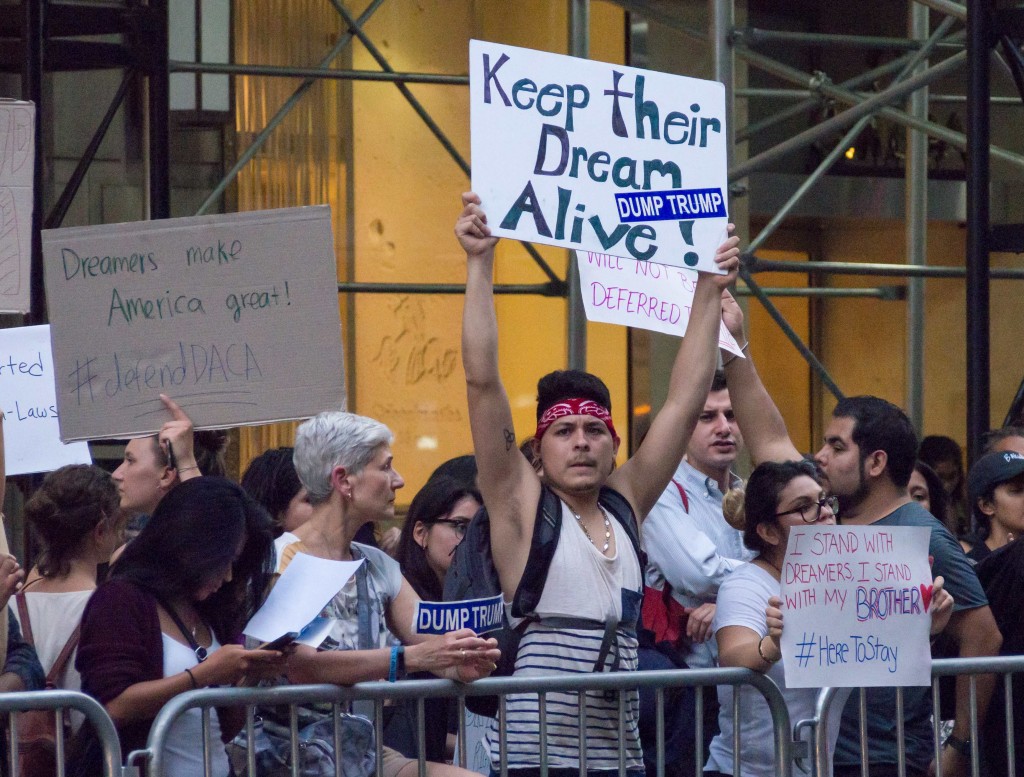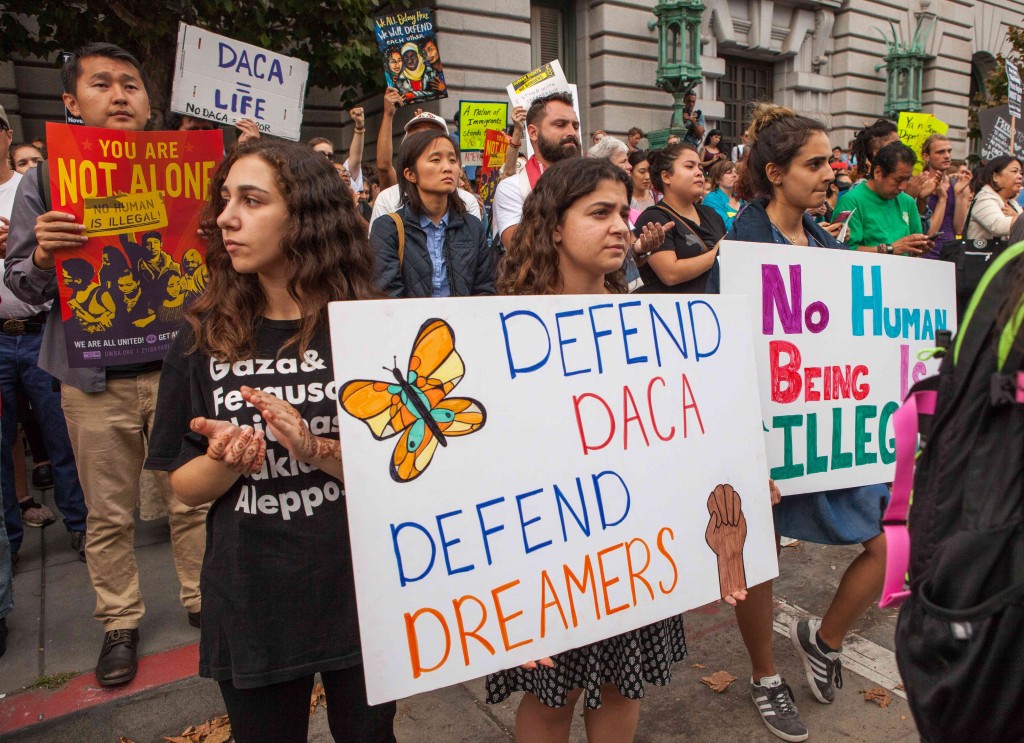Human Rights Column: Do Refugees Have Rights?

Protest in support of DACA at Trump Tower in New York City, September 2017. Photo Rhododendrites, CC BY-SA 4.0.
The distinction between “illegitimate” migrants fleeing poverty and “legitimate” refugees escaping political persecution originated during the Cold War to bolster the anti-communist aggression of U.S. and Western governments. Today, it’s used to justify some of the greatest atrocities of our times.
Speaking before Congress in May, Homeland Security Secretary Kirstjen Nielsen declared: “Asylum is for people fleeing persecution, not those searching for a better job, yet our broken system, with its debilitating court rulings, a crushing backlog and gaping loopholes, allows illegal migrants to get into our country anyway, and for whatever reason they want.” Her statement, of course, was not intended to expand protections for asylum-seekers. Nielsen instead insisted that asylum protections should be further restricted in order to close “loopholes” and prevent the “scamming of the system.”
The differentiation between “illegitimate” migrants fleeing poverty and “legitimate” refugees escaping political persecution has emerged as a key Trump administration talking point to justify a vicious crackdown on all border crossers. But the distinction predates the current White House. It originated during the Cold War to bolster the anti-communist aggression of U.S. and Western governments. Ever since, the division of displaced people into those “deserving” and “undeserving” of protections has served the political interests of the powerful. Yet these categories are too often treated as natural and given—even by supposedly neutral bodies like the United Nations. In the hands of the Trump administration, such labels are used to justify some of the greatest atrocities of our times.
The division of displaced people into those “deserving” and “undeserving” of protections has served the political interests of the powerful.
As I have pointed out for In These Times, the 1951 UN Refugee Convention that birthed the modern notion of the refugee was established during the Cold War and disproportionately shaped by the United States, Western European countries, and American allies. According to the treaty, a refugee is someone with a reasonable fear of persecution “for reasons of race, religion, nationality, membership of a particular social group or political opinion.” This category notably excludes poverty, limiting its scope to civil—and not economic—rights. In effect, such a framework reflects bourgeois capitalist morality, which casts the redistribution of wealth as a violation of personal freedoms—and denies the violence of poverty.
These bourgeois values intersect with unbridled racism. In the United States, the McCarran-Walter Act of 1952 allowed the government to shut out “undesirable” ethnicities and refuse border crossers suspected of being communists. The U.S. Refugee Relief Act of 1953 soon followed, defining a refugee as someone seeking protection in a non-communist country. The notion that the United States, as the leader of the “free world,” welcomes in those persecuted by geopolitical foes—but not the impoverished and dispossessed—has guided presidential administrations ever since. In one disgraceful example, President Dwight D. Eisenhower deported more than one million Mexicans in 1954 under “Operation Wetback.” And in the 1980s, President Ronald Reagan slammed the door on many people fleeing persecution in El Salvador—whose government was allied with the United States—by classifying them as economic migrants, not refugees.
In the U.N.’s definition of refugees, bourgeois values intersect with unbridled racism.
The Refugee Act of 1980 brings the U.S. government’s definition of a refugee closely in line with the language of the 1951 UN Convention. But the Trump administration is now using its powers to further narrow society’s determination of who counts as a refugee. In June, for example, Attorney General Jeff Sessions exercised his authority over immigration courts to upend key protections for survivors of domestic and gang violence, effectively slamming the door on thousands of people fleeing dangerous conditions in El Salvador, Guatemala, Honduras and beyond.
The path to asylum is being obstructed at numerous other points as well. Over the past year alone, the Trump administration has refused to renew Temporary Protected Status for tens of thousands of people from Honduras, Haiti, and El Salvador. Immigration lawyers say U.S. border authorities are effectively blocking off the ports of entry designated for asylum-seekers. Meanwhile, some asylum-seekers face such prolonged detention that they’ve given up on their claims.
As the Trump administration has brutally showcased, it was willing to separate up to 3,000 children from their parents, with little concern about why they were seeking entry to the United States. Following public outrage and intervention from the courts, the Trump administration claimed it would reunite children with their parents—in immigrant detention—following Obama’s chilling precedent of mass-jailing children. Meanwhile, Trump has not even met this judicial mandate, and thousands of children remain separated. As Trump openly schemes to build military camps to detain immigrant families, many live in terror of what his new mandate will bring.
The notion that the United States offers a fair asylum process has long been a myth, and never more so than under Trump. But immigration authorities are enacting brutal policies across the board. And the more the system cracks down on one kind of border crosser, the more it comes after everyone. During Trump’s first year, immigration arrests increased 41 percent compared to 2016, while thanks to Sessions’ “zero-tolerance” policy, all border crossers face a dramatic uptick in criminal prosecutions. And of course, Trump directly oversees Immigration and Customs Enforcement (ICE), a post-9/11 armed police force designed for carrying out mass deportations. Under this regime, neither “refugees” nor “migrants” are safe.
The notion that the United States offers a fair asylum process has long been a myth.
As the humanitarian organization No More Deaths/No Más Muertes has documented in harrowing detail, thousands of people have perished in the U.S.-Mexico borderlands after being chased by immigration authorities through deadly terrain. It’s important to remember that this mass killing force predates the Trump administration: The group asserted in 2016 that “the known disappearance of thousands of people in the remote wilderness of the U.S.–Mexico border zone marks one of the great historical crimes of our day.” While the Trump administration targets and persecutes humanitarian activists seeking to provide life-saving water at the border, this death count is likely to increase.
Some cheerleaders of Trump’s crackdown claim it is necessary to protect “legitimate” asylum-seekers. Brandon Judd, the president of the National Border Patrol Council and a close ally of Trump, argued in a June column for Fox News that a wall between the United States and Mexico will keep out illegitimate migrants while freeing “the resources necessary to expedite legal immigration and review the ever-growing backlog of asylum claims.”
But leading immigrant justice organizations are not taking the bait. For groups like Mijente, the aim is to chip away at a deportation machine that upends—and even ends—lives, rips loved ones apart from each other, and denies the most basic right to safety, whether one is fleeing poverty or narrowly defined political persecution. In its new platform, the organization calls for “immigration policies that not only call for the abolition of immigration enforcement agencies, but for full-scale decriminalization of immigration.”
Meanwhile, the undocumented network Movimiento Cosecha—which focuses on organizing undocumented workers in the United States—pledges that it “will not stop” until it wins permanent protection for the estimated 11 million undocumented people living in the United States. The organizing will continue, the group says, “until the dignity of each human is the same regardless of skin color and until this country shows respect for the sacrifices we have made to be here.”
Thanks to the hard work of undocumented movements during the Obama years, and public outrage at Trump’s child separations, the demand to abolish ICE has broken into the political mainstream. Democratic Socialist candidate for New York’s 14th Congressional District, Alexandria Ocasio-Cortez, defeated powerful incumbent Joe Crowley with a campaign platform that included the demand to abolish ICE. This call has even been repeated by Democratic Party heavyweights, including Sen. Elizabeth Warren (D-Mass.), and Rep. Mark Pocan (D-Wisc.) is poised to introduce a bill to abolish ICE. However, the legislation is not expected to alter immigration laws, and Pocan has been explicit about his intention to establish a replacement or alternative for ICE—raising concern that Democratic Party efforts will not ultimately abolish the core injustices that inspired public protests.
Irene Romulo, an organizer with the Chicago-based group Organized Communities Against Deportations, told me in July that she is glad the call to abolish ICE is catching fire, but she is concerned about efforts to merely rename the agency or transfer ICE functions to other institutions. “As long as they continue to target, detain, deport and incarcerate people they will always be the same, no matter under what department or what name,” she said.
Romulo is part of a growing and uncompromising movement led by undocumented people who insist all immigrants are worthy of refuge and safety—and refuse the terms of a U.S. deportation machine that scapegoats “undeserving” border crossers as it clamps down on everyone. This system was shaped by American imperialism during the Cold War and—now under Trump’s control—its ideological foundations must be torn down.
Sarah Lazare is web editor at In These Times. She comes from a background in independent journalism for publications including The Nation, Tom Dispatch, YES! Magazine, and Al Jazeera America. A former staff writer for AlterNet and Common Dreams, Sarah co-edited the book About Face: Military Resisters Turn Against War. Sarah got her start in journalism reporting for the Independent Media Center movement.













